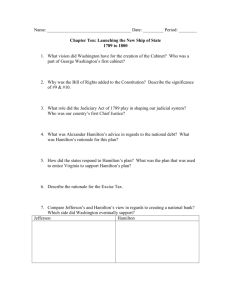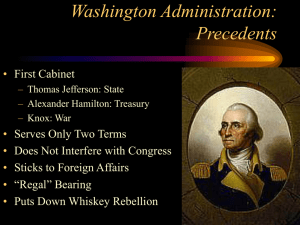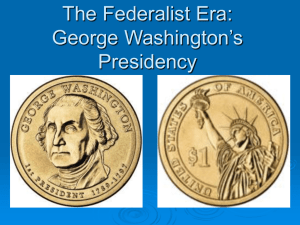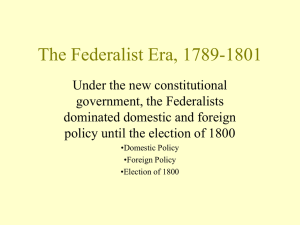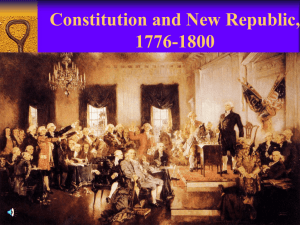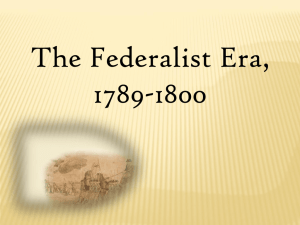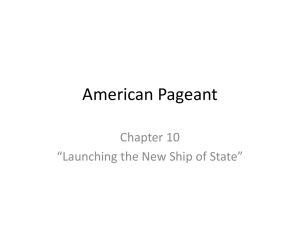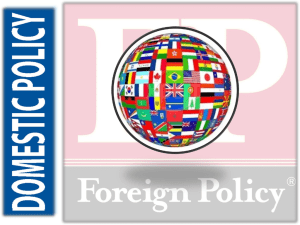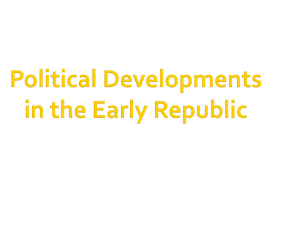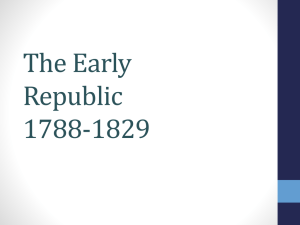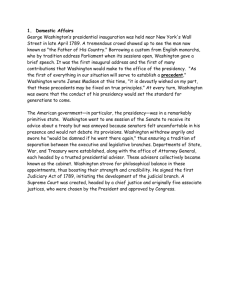APUS Unit 3 Ch.10 The New Nation PPT
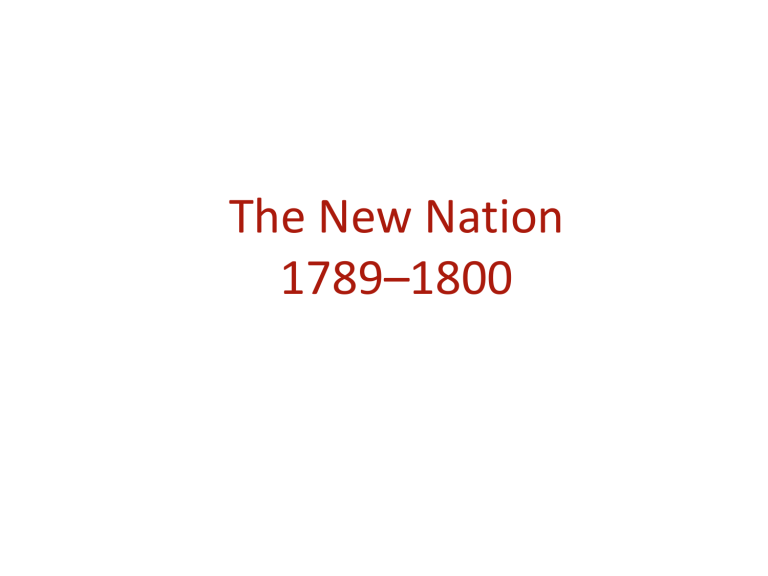
The New Nation
1789–1800
p201
• Calls during the ratification process for greater guarantees of rights resulted in the addition of a Bill of Rights shortly after the Constitution was adopted.
Demographics of the new nation
• Census 1790
• 4 million people
• Cities growing- Philadelphia, New York, Boston,
Charleston, and Baltimore
• 90% rural
• 95% lived east of the Appalachians
• Within fourteen years, Vermont, Kentucky,
Tennessee, and Ohio all added as states within 14 years
• As the first national administrations began to govern under the Constitution, continued debates about such issues as the relationship between the national government and the states, economic policy, and the conduct of foreign affairs led to the creation of political parties.
– Kentucky and Virginia Resolutions
– Hamilton’s Financial Plan
– Proclamation of Neutrality
Election of Washington
• Unanimously chosen by the Electoral College in 1789
– Only presidential nominee to be chosen unanimously
• Took oath of office on April 30, 1789 in NYC
Department Heads Under
Washington
• Secretary of State- Thomas Jefferson
• Secretary of the Treasury- Alexander Hamilton
• Secretary of War- Henry Knox
Table 10-1 p182
Bill of Rights
• Adopted in 1791
• Protection of freedoms
– Freedom of speech, press, religion, assembly and petition
– bear arms, trial by jury
• Protection against abuse of power
– No cruel and unusual punishment
– Protection against arbitrary gov’t seizure of private property
• 9 th Amendment
– People have rights beyond those enumerated
• 10 th Amendment
– All powers not delegated or prohibited by the
Constitution belong to the states or the people
Judiciary Act of 1789
• Organized the Supreme Court (John Jay became the first Chief Justice)
• Established federal district and circuit courts
• Established the office of attorney general
Hamilton’s Financial Plan
• “Funding at par”
– Federal government would pay off its debts at face value- more than $54 million
– (people had been losing faith that the new government would be able to meet its obligations and the value of government bonds had depreciated to 10-15 cents on the dollar)
• “Assumption”
– Federal government would assume state debts.
This would tie the states more to the fed. gov’t.
The Bargain
• 1790
• Hamilton convinced Jefferson to support the plan for assumption in return for the new federal district (D.C.) to be located on the
Potomac
Figure 10-1 p184
Debt as a national blessing?
If the government owes people money, those people have a stake in the success of that government
Revenue
• Foreign trade and protection of American manufacturing were two elements of Hamilton’s economic plan
• Custom duties (tariff revenues)
– Dependent upon foreign trade
– 1789 a low tariff was passed
• Designed to raise revenue and protect infant industries
• Excise taxes (internal tax on certain goods)
– Whiskey
– Fell heavily on backcountry distillers
Whiskey Rebellion
• 1794, southwestern Pennsylvania
• Distillers used arguments and symbols of the
Revolution
• Washington called for militias from the states.
13,000 troops responded.
• Whiskey Rebellion faded.
• Government was strengthened
p185
A National Bank
• Hamilton proposed it
– Argued that the Necessary and Proper (“elastic”) clause gave the government the authority to create one. This was an “implied power.”
-”loose construction”
• Jefferson opposed it
– Argued that since it was not in the Constitution, the power to create banks remained with the states (Article X)
• Washington signed it into law
• The Bank of the United States created 1791
– Chartered for 20 years
– Capital of $10 million (1/5 th owned by Fed. Gov’t)
Spirit, pp.190-203
• Where do Hamilton and Jefferson stand on the various issues?
• At its core, what is their debate really about?
Pair-Share
• What do you know about our two current political parties and the two-party system?
Political Opinion Poll
• Political opinion pollhttp://www.peoplepress.org/political-party-quiz/newshour/
The Emergence of
Political Parties
• Organized opposition to Hamilton’s revenueraising and centralizing policies began to build
• Previously, factions (Whigs/Tories, Feds/Anti-
Feds) had existed as opposed to organized political parties
• Beginning of America’s two-party system
• The party out of power (“the loyal opposition”) acts as a check on the party in power
Table 10-2 p186
Table 10-3 p198
• To what extent do our current political parties align to Hamilton’s Federalists and Jefferson’s
Democratic-Republicans?
Assignment
Washington’s Farewell Address http://avalon.law.yale.edu/18th_century/washing.asp
-Briefly summarize George Washington's beliefs about political parties.
-What warning about foreign nations does Washington give in his farewell address? Why was it to the advantage of America to remain aloof? Did Washington reject all alliances in all circumstances? Are the concerns that Washington had about the nation's foreign affairs still applicable today? Why or why not?
-Why do you think Washington was so concerned about these two issues (political parties and foreign entanglements)?
-Considering the role of political parties in our country today, were
Washington's concerns valid?
Foreign Policy
Key Concepts- Review
• In response to domestic and international tensions, the new United States debated and formulated foreign policy initiatives and asserted an international presence.
• As western settlers sought free navigation of the Mississippi River, the U.S. forged diplomatic initiatives to manage the conflict with Spain and to deal with the continued
British presence on the American continent.
The French Revolution
• 1789
• 1792 France declared itself a Republic
• 1793 King Louis XVI beheaded and Reign of
Terror begins
• The French Revolution’s spread throughout
Europe and beyond helped fuel Americans’ debate not only about the nature of the
United States’ domestic order but also about its proper role in the world.
p188
p187
• French Revolution was initially supported by many Americans, especially Jefferson and the
Democratic-Republicans
• When a world war erupted as a result, however, Americans became less supportive
Neutrality Proclamation
• 1793
• Officially declared America’s neutrality in the battle between England and France
• Marked the beginning of America’s isolationist tradition
Key Concept
• During and after the colonial war for independence, various tribes attempted to forge advantageous political alliances with one another and with European powers to protect their interests, limit migration of white settlers, and maintain their tribal lands.
– Iroquois Confederation, Chief Little Turtle, and the
Western Confederacy
Map 10-1 p191
• 1790-1791 Chief Little Turtle and the Miami
Confederacy (which had been armed by the
British) defeat U.S. forces in one of the worst
U.S. defeats in the history of the frontier
• 1794 Battle of Fallen Timbers
– Miamis defeated
• Treaty of Greenville (1795)- the Miami Indians surrendered their claims to much of the Old
Northwest.
p192
Map 9-3 p167
Tensions w/ Britain
• British goods flooded the American market while American exports were blocked by
British trade restrictions and tariffs
• Britain maintained forts in North America that they had agreed to leave under the Treaty of
Paris
• Britain impressed American sailors and seized naval and military supplies from American ships
Jay’s Treaty
• 1794-95
• Britain agreed to abandon the northwestern forts and provided the U.S. with a commercial treaty
(although U.S. commerce with the British West
Indies remained restricted).
• Other issues (Canadian-Maine border, compensation for pre-revolutionary debts, and
British seizures of American ships) were to be resolved by arbitration.
• Maintained peace with Britain, but was unpopular with the American public.
Pinckney’s Treaty
• 1795
• Resolved territorial disputes between Spain and the U.S.
• Granted American ships the right to free navigation of the Mississippi and duty free transport through the port of New Orleans
Key Concept
• Although George Washington’s Farewell
Address warned about the dangers of divisive political parties and permanent foreign alliances, European conflict and tensions with
Britain and France fueled increasingly bitter partisan debates throughout the 1790s.
Washington’s Farewell Address
• 1796
• Printed in the newspapers
• Warned against permanent alliances
(Washington favored temporary alliances for extraordinary emergencies)
State of the Union
• The central government was solidly established
• The country was expanding
• International commerce was growing
• U.S. had avoided foreign entanglements
• “The experimental stage had passed. . . .”
(p.201)
